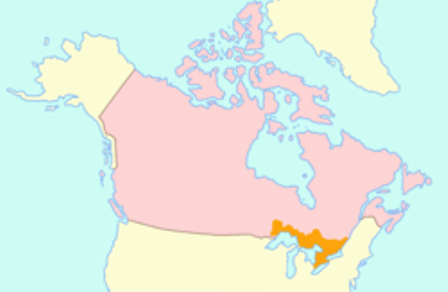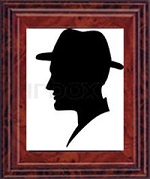Frederick John Levi was born in Amherstburg, Essex, Ontario, Canada around 1762.
He married Mahdelene "Magdelene" (Modlin) Bellegrade in Essex, Ontario, Canada.
She was born about 1764. He died before 1836.
The following information was gathered by Dewey J. Levi and Paul D. Levi and was published
in their book, "Frederick John Levi & His Family, 1800 - 1864 that was published in July of 1994.
Frederick and Magdelene had 7 children.
Elizabeth Levi, born about 1788, and died before 1844.
John Levi, born between 1793 and 1805 and died before July 10, 1852.
Louisa Liebau, born July 8, 1799.
Frederick John Levi, born October 17, 1800 and died April 10, 1864.
Catherine Leebo, born about 1806 at the time residing in L'Assomtion, Windsor, Essex, Ontario.
She married James Cahill. Catherine died about May 1861 in Essex, Ontario, Canada and was buried
on May 24, 1861 in L'Assomption, Windsor, Essex, Ontario, Canada.
Mary Ann Levi, born about 1808. She married Jonathan Tallerton on March 12, 1833 in Blenheumi, Kent,
Ontario, Canada.
Ann Levi, born 1812 in Blackeim, Kent, Canada
Levi Background in Canada
Tradition and family records have told us our earliest Levi ancestors came from Essex, Ontario, Upper Canada
(The Orange area in the map).
Many descendents have searched and paid researchers in attempt to locate the lines of Frederick Levi (Liebau) Sr.

When Paul and Rae Levie were on a research excursion in Canada in 1977, they spent most of their time in the
Mersea and Gosfield areas near Leamington, where they understood Frederick John Levi was born. Also, they understood
that his father, Frederick Levi, Sr. was also born in that area. We understood that the earliest settlers came to
the area of Point Pelee, South and East of Learnington and were driven from their lands by the Indians and then later
they were permitted to return. We were almost entirely ignorant of the early history of "Upper Canada", but were
interested in learning.
We spent two weeks searching old church and municipal records. At first we found no trace of property ownership by
Frederick Levi (either father or son). We were permitted to go into the oldest land record index books in the basement,
as we had found nothing in the regular index going all the way back to the patents. We had found record of John Whittle,
et. al., in the index, but little did we know that the other party was Frederick Levi. The basement index showed Frederick
Levi to be the other party. At that time we didn't make any connection, learning only later that they were cousins.
John Whittle and Frederick Levi had purchased by Bargain and Sale from Robert Reynolds, Lot 8, Second Concession
consisting of 200 acres for 100 pounds under the date of 19 June, 1832. There was a second entry of the same date
which appears to be satisfaction of an encumbrance and discharge. The record further shows sale of the lot by Whittle
and Levi to Michael J. Fox for 275 pounds under the date of 6 October, 1838.
Land records of many of the early settlers were reviewed; Fox, Stewart, Wigle, Whittle, Lebo, Bruner and many others.
The name of Bruner was on some property maps shown on the same Lot 8 owned by Whittle and Levi. This was of interest in
that we had from earlier studies of influential people in the area, found a possible link between the Bruners and the Levis.
Suspicion had long existed linking the family Levi with the family of Lebo or Lebeau (various spellings). At that time
we also found (same circumstances) ownership by Frederick Levi and conveyance of Lot Number Two Hundred and Thirty South
of Talbot Road West, in said Township of Mersea (by Frederick Levi of the Township of Gosfield) County of Essex and Western
District of the Province of Upper Canada, Yeoman, and Ann his wife... to Isaac Russel. This identifies the grantor as
Frederick Jr. or Frederick John and his wife Ann or Julia Ann as the grantors. Interestingly enough, the adjacent lot, Lot
229, was owned by John Lebo. There were also other frequent occurrences of the names Levi and Lebeau giving further
suspicion to a relationship, adding to earlier suspicions of my Aunt Eva Levie Barney of a connection between Levi and Lebo
or Lebeau.
Our memory then went back to earlier studies of the Bruner family in the Commemorative Biographical Record in which there
were no located references to the Levi family but wherein it was said of the Bruner’s. The name of Bruner, long known in the
county of Essex, is worthily borne in the present generation of Amon and Wellington Bruner, sons of Thomas Bruner, two of
the most enterprising farmers of the township of Gosfield South.
Henry Bruner, their grandfather, was born October 30, 1785 in Pennsylvania where he married, January 3, 1809,
Elizabeth Ulch, born October 10, 1791. They had children as follows: Mary, born October 30, 1809, married Frederick Lebeau
and lived in Mersea township; Barbara, born September 3, 1811, married Samuel Fox, and died aged 83 years; Judy, born
August 20, 1813, married John Duhurst, and died in Illinois; Adam, born September 7, 1815, married M. Lebeau (later
confirmed to be Modlin or Madelin (Lebeau or Levy).
The search has been continued by many descendants, but there has been little found of the place of origin of Frederick
Levi (Lebeau). Further extensive search has been made recently by Dewey J. Levi into early Canadian history also without
absolute success.
Background of the early settlement of Upper Canada is interesting and almost necessary for us to further pursue the
genealogy of Frederick Alevi Sr. Through further research, our efforts and interest has now also shifted to the Amhurstburg
and Detroit areas.
In his preface to "The Windsor Border Region" by Father E. Lajeunesse, Mr. Leslie Frost, then premier of Ontario wrote:
There is only one locality in the Province of Ontario that can claim a continuous settlement antedating the British
conquest. That locality is the Windsor area on the Canadian side of the Detroit River.
Canada has been a French colony since the coming of Jacques Cartier in 1534. For over two centuries, it remained little
more than a French military and trading post. Fur traders and coureurs de bois abounded as did a network of forts extending
from Quebec City and Montreal westward to Fort Frontenac on Lake Ontario and to Fort Duquesne and other areas Southwest
amidst the Ohio and Missouri River regions.
However, unlike the early English colonies in America, the French settlements failed to attract permanent settlers. By
the time of the Revolutionary War in 1776, approximately 2,500,000 (primarity of English descent) inhabited the American
colonies whereas less than 100,000 Frenchmen were found in Canada, or as it was then called, New France. The claims and
interests of the two European powers led to inevitable clashes. Opposing territorial claims led to recurring warfare
which was not settled until the end of the Seven Years' War (17630, at which time the British dispatched a large army under
General James Wolfe to Quebec to crush the French once and for all. It is well known history that Marquis de Montcalm, the
French commander, lost the battle of the plains of Abraham in 1759 and Canada fell as a permanent prize to the English.
Because of the steady growth in numbers of new settlers who arrived in Canada, it was decided to split the colony, Lower
Canada was the more Easterly, French settlement, where the cultural influence of the French Roman Catholics was dominant;
and Upper Canada was the more Westerly English settlement, literally "up" the St. Lawrence River from Montreal.
By 1812, eight out of every ten persons in the province were of American birth or of American descent. Although the
original Loyalists who came to Canada immediately following the Revolutionary War did so in large because of British
loyalties, the succeeding and much larger waves of American settlers were attracted to the Canadian frontier for a variety
of other reasons. As the American frontier pushed West, eager settlers were determined to capitalize on large new land tracts
and favorable farming opportunities. The argument of cheaper land was used to good advantage in Upper Canada. For some,
a significant factor was the 1791 Constitutional Act which not only politically divided Quebec, but more importantly
insured the existence of a new province, Upper Canada, that would not be dominated by the French and by the Roman
Catholic Church. Others were attracted by the fact that Indian problems were greatly minimized in that province. A
further important factor was its geographical proximity and increasing accessibility by improvement of roads and
steamship and canal transportation. Some preferred to sail from American costal ports to new homes in Canada than
to trudge through unimproved roads or trails over land.
Until the War of 1812, the population of Upper Canada remained well below the 100,000 mark, but by 1824, that number
had climbed upwards to 150,000. By 1846 it had climbed to 451,000. Still by 1840, a sizable majority of the Canadian
population lived within one to two hundred miles of the states of New York, Ohio, Vermont, and Pennsylvania
Link to Chapter 2

